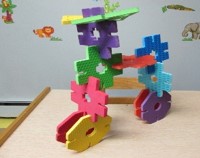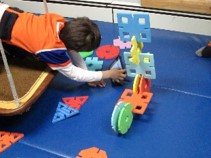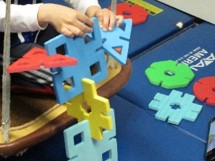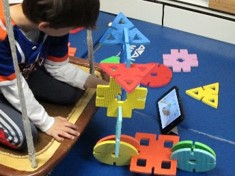When presented with a child who has weak “upper body strength” (generally meaning low tone throughout, including poor postural control, slushy or dysarthric speech, poor ocular motility/ visual search patterns, and poor spatial orientation), the need to follow a developmental frame of reference comes into view. While engaging the interest and intellect of the child is a key part of intervention, use of strategies that address the underlying causes of the child’s multiple issues will ultimately provide for a more consolidated outcome.
 For example, this intervention session began by addressing underlying issues of poor response to proprioceptive input (as shown by the low tone) by use of the Wilbarger Deep Pressure Protocol followed by use of weighted wearables (stretchable weighted vest and ankle weights), and having the child view the project to be made on the tablet screen to capture his interest.
For example, this intervention session began by addressing underlying issues of poor response to proprioceptive input (as shown by the low tone) by use of the Wilbarger Deep Pressure Protocol followed by use of weighted wearables (stretchable weighted vest and ankle weights), and having the child view the project to be made on the tablet screen to capture his interest.
 The parts of the toy were scattered around a platform swing, to address his deficits in body awareness and visual pursuits. He had to navigate moving about the swing which resulted in activating vestibular and proprioceptive input through irregular swing sway. Attention to internal body maps were spontaneously triggered to provide postural stability to avoid falls, while he visually searched for parts needed for task assembly .
The parts of the toy were scattered around a platform swing, to address his deficits in body awareness and visual pursuits. He had to navigate moving about the swing which resulted in activating vestibular and proprioceptive input through irregular swing sway. Attention to internal body maps were spontaneously triggered to provide postural stability to avoid falls, while he visually searched for parts needed for task assembly .
 The task was set up to require use of extended reach from quadruped in order to assemble the parts. The boy was prompted to sit at the front of the swing to assemble and balance the base of the project and then to use the swing to obtain the other parts needed. Once again, in order to prevent falls, activation of patterns of upper body stabilization were spontaneously triggered.
The task was set up to require use of extended reach from quadruped in order to assemble the parts. The boy was prompted to sit at the front of the swing to assemble and balance the base of the project and then to use the swing to obtain the other parts needed. Once again, in order to prevent falls, activation of patterns of upper body stabilization were spontaneously triggered.
 Emergence of bilateral motor integration patterns were shown with reciprocity as one hand stabilized the project while the other hand manipulated the pieces to be attached. No prompting was needed at this point. The oversized pieces combined with gravity provided natural consequences for errors in force and timing.
Emergence of bilateral motor integration patterns were shown with reciprocity as one hand stabilized the project while the other hand manipulated the pieces to be attached. No prompting was needed at this point. The oversized pieces combined with gravity provided natural consequences for errors in force and timing.

A measure of self-monitoring was also noted to emerge as the youngster began to check the steps of his project with each frame of the task as he swiped the tablet to proceed with each step.

Comments are closed.